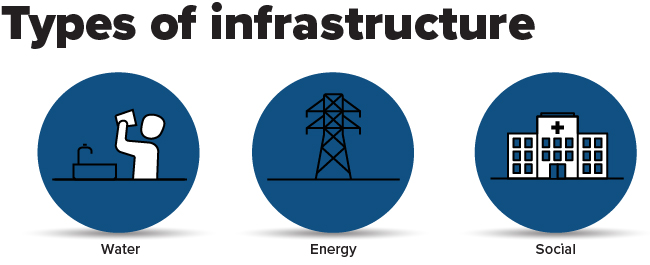Evaluation of current urban policy frameworks for Australia’s cities identified the provision of infrastructure as a key feature. This Brief focuses on water and energy resources, social infrastructure and funding mechanisms; other forms of infrastructure such as transport and telecommunications are addressed in separate themes.

Infrastructure Australia was established in 2008 as an independent body to advise the public and private sector on investments and reforms needed to make better infrastructure decisions. Subsequently, to identify and prioritise infrastructure needs at a state level Infrastructure NSW was founded in 2011 and Infrastructure Victoria in 2015. Newly established Infrastructure SA and Infrastructure WA are currently developing their state-wide infrastructure strategy. The advocacy of these agencies dedicated to infrastructure matters is shaping the way urban policies are framing interventions in Australian cities.
Energy and water resources
The provision of water and energy are two key resources that are specifically addressed within urban policies. Infrastructure Australia encourages private sector investment to deliver secure, reliable, affordable and low emissions supply. More competition is seen as providing more efficient markets. Further investments are encouraged in Victoria's 30-Year Infrastructure Strategy to expand the supply of energy to enable the transition to lower emissions energy sources.
Water scarcity is a main concern in metropolitan planning strategies and ensuring water security and quality is a key requirement. A key objective of the 30-Year Plan for Greater Adelaide is to protect and secure water resources by reducing consumption, desalinating sea water and developing ways to increase water efficiency. Infrastructure Australia identified in its Infrastructure Priority List, a national water strategy and town and city water security as new high priority initiatives. Research by AHURI found that Australian households have an overwhelmingly positive attitude towards energy and water conservation, and support strategies that encourage voluntary change through services and incentives rather than through pricing or tax mechanisms.
AHURI research argues for housing also to be considered a form of essential social infrastructure that warrants public investment.
Social infrastructure
The provision of social infrastructure, in the form of education, health, justice and recreation facilities, is addressed in urban policies as a key feature of shaping Australia’s cities. AHURI research argues for housing also to be considered a form of essential social infrastructure that warrants public investment. Social housing supports a range of social objectives, such as in public health, economic development and addressing market failure in the housing market. The Central Darwin Area Plan emphasises the need to identify and build social infrastructure that meets the needs and aspirations of the community in order to improve the quality of life.
Metropolitan planning strategies recognise that existing social infrastructure needs to be renewed and improved to contribute to a well-functioning city. By developing more integrated approaches for existing facilities, they could be used more efficiently. For example, by providing better recreational facilities, such as public parks and sports centres, more people would be encouraged to use them, leading to improved health outcomes. To keep up with demand coming from Australia’s population growing more recreational facilities need to be built. Recent AHURI research has examined the delivery of social infrastructure in outer suburban growth areas in relation to the supply of new residential dwellings and population growth. Urban policies emphasise the need to ensure that new residential land use is developed in proximity to social infrastructure to improve outcomes for local communities.
Funding mechanisms
A key focus of urban policies is to maintain and renew existing infrastructure as well as to build new infrastructure to accommodate population and economic growth. To facilitate the delivery of projects Infrastructure Australia calls for increasing and sustaining funding by implementing more efficient delivery models and diversifying funding pools such as through incorporating private sector investment. This is particularly the case in the delivery of transport infrastructure, where different models of building infrastructure and ongoing funding are presented. Infrastructure Australia proposes introducing a road charging structure for freight and personal vehicles, instead of the current taxes on fuel and registration charges, to develop a more efficient and equitable funding stream. This change in funding is partially related to the potential of electrical and autonomous cars becoming more prevalent and their impact on current funding models, as these vehicles would not pay taxes on fuel and, through car-sharing models, would reduce the number of registered vehicles.

